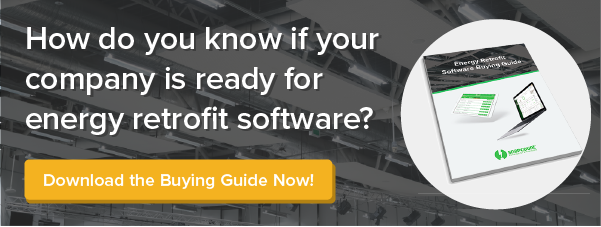
Energy efficiency is BIG business. NAESCO reports that Energy Service Companies (ESCO’s) add $7 billion of business to the national economy every year, doing work in every state of the country. Government and business leaders are making building energy management a priority and are turning to ESCOs to make it happen.
In turn, ESCOs need expert subcontractors to secure and execute their projects.
For lighting retrofitters, working with ESCOs provides huge business opportunities. But to work effectively with them, you need the right strategies.
Tip #1: Build a Relationship for the Long Term
The ESCO sales cycle is a long one. An ESCO may be brought in on the project directly by the customer or may be one of several asked to bid. The first step will be a detailed scoping and audit process to identify and evaluate the customer’s energy saving opportunities and to develop the engineering designs and specifications for the project.
What follows is an approval process that can involve lawyers, boards of education, and other entities. It's not uncommon for the ESCO proposal to go through multiple iterations and require two or three different options within each iteration. Having complete, comprehensive, and well organized audit data will make it easier for you to respond to each request from the ESCO to rework the numbers.
Bottom line: while worth it, these contracts take a while to happen, so you can’t let frustration from the round-and-round get in the way of a profitable business alliance.
Instead, use the opportunity to build a solid, mutually respectful working relationship with the ESCO. Find out what their working style is like and how they like to communicate, and make sure you can help them meet their goals: delivering savings and making the customer happy.
The stronger the relationship and the more seamlessly you can meet the ESCOs needs, the more likely you are to become their go-to.
Tip #2: Gather the Information You Need up Front
Be clear with the ESCO about your requirements to do the job right. To make sure these requirements are accurate, your people onsite will need time to:
- Do a thorough audit
- Get accurate light levels
- Take all the pictures and videos needed
- Create maps and sketches
- Look above the ceiling to identify installation challenges
- And much more
With this level of detail, you’ll be able to respond and reprice accurately if at some point in the process there’s a request for a different retrofit type or fixture.
As the project proceeds, you can head off misunderstandings from the start by having a clear understanding of what the ESCO’s expectations are for your company —including the deliverables they expect at every stage of the project, such as day loggers or measurement and verification.
It’s worth noting, however, that as prepared as you might be, you also need to be flexible. Sometimes customers forget to mention things, so you should be prepared for the possibility you may have make a return trip to a site, city, or facility because the customer left out the transportation piece or egress and emergency lighting weren’t mentioned.
Making the ESCO look good is your job number one, so make sure you have all the information you need to deliver on that promise. When the ESCO succeeds, your company does too.
Tip #3: Accuracy and Speed Are Critical
Is your operation and workflow as efficient as it can be? Because working with an ESCO will put your processes to the ultimate test. Here’s why.
Many ESCOs make their proposals to customers more attractive using a budget-neutral approach called energy savings performance contracting (ESPC). The idea is that the ESCO and the customer share in the dollars saved from the customer’s lower energy consumption. Those energy savings allow the customer to pay for the energy upgrades without having to tap into capital budgets. For the ESCO, that means they must generate the promised energy consumption cost savings to get paid.
The ESCO will be under pressure to deliver on the performance specified in the proposal to be profitable, and as their subcontractor, so will you. The ESCO will expect you to have your numbers straight and be ready to roll when the call comes.
You’ll need to be accurate
The systems you have for auditing and costing projects need to be spot on, because your profitability will depend on it. You’ll need tools that allow you to price and calculate potential savings with accuracy and precision.
You may also be asked to work open book. Hand-written audit notes or inscrutable Excel spreadsheet formulas won’t cut it with the ESCO. Understand that if you are producing a quote for a performance contract, you will have to live with the consequences if you make a miscalculation.
You’ll need to be fast
Once you've been awarded a job, the ESCO is going to put pressure on you to get started, pronto. They will want you to have all the materials ordered immediately because they can't begin generating revenue until materials are on site. Having orders prepared and ready to go is a smart idea and will reassure the ESCO about your preparedness.
You should focus on fit checks early on. You may have 90% confidence that all the specified fixtures are going to fit—and you’ve already examined what’s above the ceiling—but the wall packs or retrofit kits that don't fit must get addressed right away so you don’t face delays once installation gets rolling.
Be a High Performance Partner for ESCOs
If your company’s growth strategy depends on securing ESCO business, then applying these three strategies will set you up for success. By getting to know the ESCO, getting complete information up front, and showing that your company is professional and dependable, you can secure the ultimate prize: repeat business.
ESCOs and their customers have high expectations at every phase of an energy efficiency project. You need to have internal processes that support your best work and won’t let you down under pressure. If you’re considering lighting retrofit audit software, our Lighting & Retrofit Software Buying Guide can walk you through your options and the pros and cons of each.






Share this post: